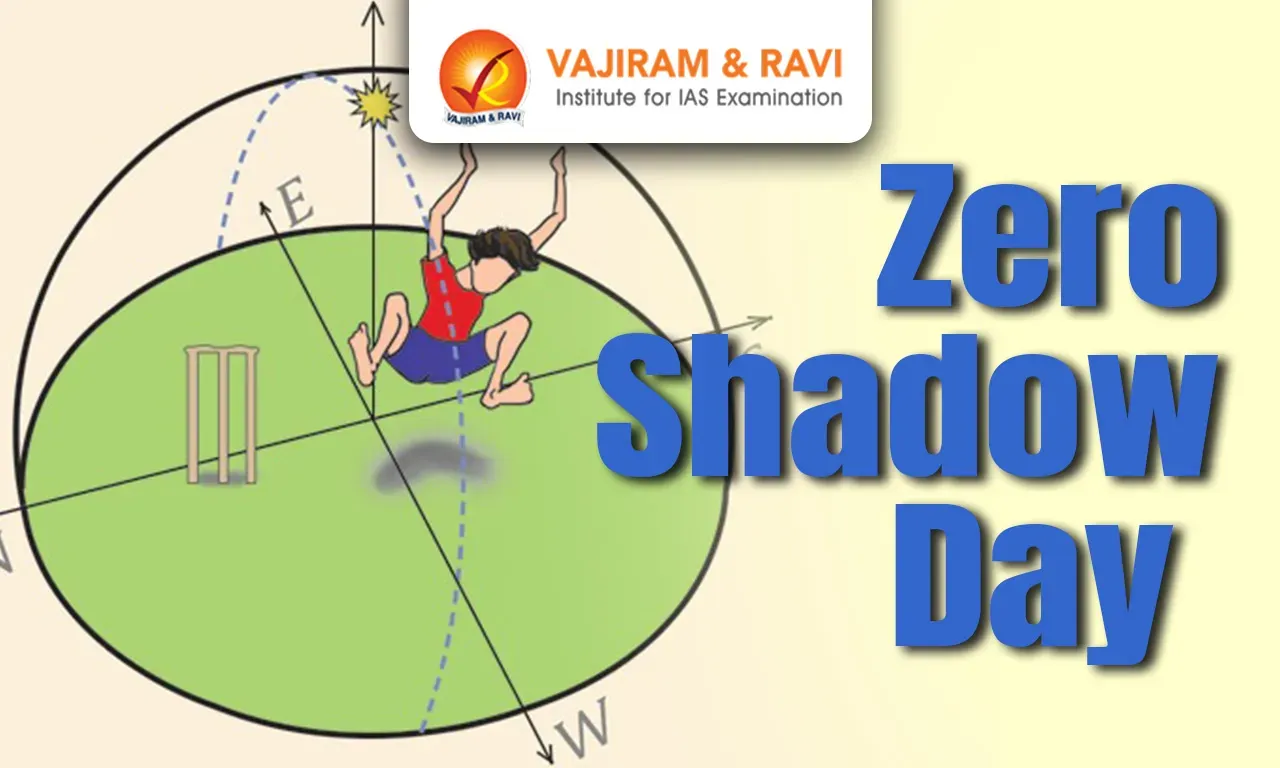Zero Shadow Day Latest News
The Cosmology Education and Research Training Center (COSMOS), Mysuru, of the Indian Institute of Astrophysics recently observed ‘Zero Shadow Day’.
About Zero Shadow Day
- It is an interesting celestial phenomenon that occurs twice in a year when the sun is directly overhead and thus no shadow of any vertical object can be seen.
- This event happens for locations situated between the Tropic of Cancer and the Tropic of Capricorn.
- The ZSD phenomenon transpires when the Sun’s declination becomes equal to the latitude of the location.
- On this day, as the sun crosses the local meridian, its rays fall exactly vertically relative to an object on the ground, making it impossible to observe any shadow of that object.
- This is due to the tilt of the Earth’s axis and its rotation around the sun, causing the angle of the sun’s rays to change throughout the year, which in turn affects the lengths and directions of shadows.
- When does it occur?
- There are two zero shadow days every year, observed in placesthat lie between the Tropic of Cancer and the Tropic of Capricorn.
- One falls during the Uttarayan (when the Sun moves northwards), and the other is during Dakshinayan (when the Sun moves southwards).
- It will clearly be different for different places on earth.
- It lasts for a small part of a second, but the effect can be seen for a minute to a minute-and-a-half.
- The southern part of India, roughly below the latitude of Bhopal, will experience the ZSD.
- The states that can see this event are Andaman and Nicobar Islands, Kerala, Tamil Nadu, Puducherry, Karnataka, Andhra Pradesh, Telangana, Goa, Maharashtra, Odisha, Daman & Diu, Dadra & Nagar Haveli, most of Gujarat and Chhattisgarh, and the southern parts of Madhya Pradesh, Jharkhand, West Bengal, Tripura, and Mizoram.
Zero Shadow Day FAQs
Q1. What is Zero Shadow Day?
Ans. A day when the sun is directly overhead and vertical objects cast no shadow.
Q2. Zero Shadow Day occurs in regions located between which two latitudes?
Ans. Tropic of Cancer and Tropic of Capricorn
Q3. How many times does Zero Shadow Day occur at a given location in a year?
Ans. Twice
Source: TH
Last updated on December, 2025
→ Check out the latest UPSC Syllabus 2026 here.
→ Join Vajiram & Ravi’s Interview Guidance Programme for expert help to crack your final UPSC stage.
→ UPSC Mains Result 2025 is now out.
→ UPSC Notification 2026 is scheduled to be released on January 14, 2026.
→ UPSC Calendar 2026 is released on 15th May, 2025.
→ The UPSC Vacancy 2025 were released 1129, out of which 979 were for UPSC CSE and remaining 150 are for UPSC IFoS.
→ UPSC Prelims 2026 will be conducted on 24th May, 2026 & UPSC Mains 2026 will be conducted on 21st August 2026.
→ The UPSC Selection Process is of 3 stages-Prelims, Mains and Interview.
→ UPSC Result 2024 is released with latest UPSC Marksheet 2024. Check Now!
→ UPSC Prelims Result 2025 is out now for the CSE held on 25 May 2025.
→ UPSC Toppers List 2024 is released now. Shakti Dubey is UPSC AIR 1 2024 Topper.
→ UPSC Prelims Question Paper 2025 and Unofficial Prelims Answer Key 2025 are available now.
→ UPSC Mains Question Paper 2025 is out for Essay, GS 1, 2, 3 & GS 4.
→ UPSC Mains Indian Language Question Paper 2025 is now out.
→ UPSC Mains Optional Question Paper 2025 is now out.
→ Also check Best IAS Coaching in Delhi
Tags: prelims pointers upsc current affairs upsc prelims current affairs zero shadow day

















